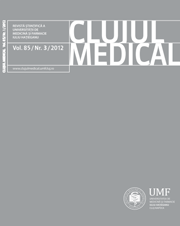Effects of Melatonin and Chitosan in the Regeneration of Rat Crushed Sciatic Nerve
Keywords:
melatonin, chitosan, sciatic nerve, regenerationAbstract
Background. The beneficial cellular protective and antioxidative effects of melatonin and chitosan, by limiting the molecular destruction, could stimulate the peripheral nerve regeneration and exert a neuroprotective action.
Aims. In this study we proposed to investigate the influence of melatonin and chitosan on the functional neuromotor recovery, by measuring the sciatic functional index (SFI) in rats with peripheral nerve injuries.
Material and methods. The sciatic nerve was acutely injured by crush lesion in 3 groups of white Wistar rats, male (n=10 animals/group). The experimental groups were: control group, group I – treated with 0,01 mg/kgc melatonin (day 1-28); group II – treated with 1,5 mg/kgc chitosan (day 1-28). SFI was determined in all groups in days 1 and 28.
Results. During the recovery period, administration of melatonin and chitosan improved significantly the functional recovery. SFI was significantly better in melatonin treated group than in chitosan treated group.
Conclusions. 1) Administration of melatonin and chitosan improves motor function in peripheral nerve lesion recovery. 2) Melatonin has favorable effects on nerve regeneration even in low-doses. 3) The beneficial antioxidative effects of melatonin treatment after sciatic nerve crush injury could persist for the whole time length of peripheral nerve recovery.
Downloads
Published
How to Cite
Issue
Section
License
The authors are required to transfer the copyright of the published paper to the journal. This is done by agreeing to sign the Copyright Assignment Form. Whenever the case, authors are also required to send permissions to reproduce material (such as illustrations) from the copyright holder.

The papers published in the journal are licensed under a Creative Commons Attribution-NonCommercial-NoDerivatives 4.0 International License.

